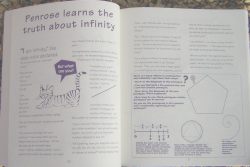Fun math and math appreciation
Some of us are math enthusiastics: we love math, think it is full of beauty, logic, and patterns; we think it can be fun, exciting, amusing even. (I include myself in this category.)
And then some of us don't care for math, didn't like it in school, didn't do well in it, don't want anything to do with it anymore. And I'm sure there are people in between these extremes, too.
As a teacher, you would like your students to belong to the first category, of course.
Now, I sincerely think that the biggest factor in whether student ends up liking or hating math is what kind of math teacher and teaching he/she gets. Parents' attitudes play a role too, but teacher's attitude to math and the way math is taught are the weightiest factors, I feel.
 But books such as The Adventures of Penrose The Mathematical Cat
But books such as The Adventures of Penrose The Mathematical Cat by Theoni Pappas can help too. It is intended for fun reading, exploring exciting mathematical topics in an easy-to-understand way.
by Theoni Pappas can help too. It is intended for fun reading, exploring exciting mathematical topics in an easy-to-understand way.
The storyline includes Penrose the mathematical cat who seems pretty lazy but often gets interested in her mistress' math papers and thus ends up learning about this and that in math.
 For example, you get to encounter 0s and 1s (binary numbers), fractals, infinity, Mobious strip, Pascal triangle, golden rectangles, paperfolding, tessellations, abacus, magic squares, tangrams, nanoworld... For math geeks, these are familiar topics. They show some of the beautiful or fun or intriguing aspects of math.
For example, you get to encounter 0s and 1s (binary numbers), fractals, infinity, Mobious strip, Pascal triangle, golden rectangles, paperfolding, tessellations, abacus, magic squares, tangrams, nanoworld... For math geeks, these are familiar topics. They show some of the beautiful or fun or intriguing aspects of math.
You could almost say this book is about "Math appreciation ". We are told to teach our kids art appreciation, to teach them to appreciate fine arts, paintings, sculptures. In my opinion, learning about these fascinating math topics can go a long way towards teaching children to appreciate math.
". We are told to teach our kids art appreciation, to teach them to appreciate fine arts, paintings, sculptures. In my opinion, learning about these fascinating math topics can go a long way towards teaching children to appreciate math.
Read the complete review here.
And then some of us don't care for math, didn't like it in school, didn't do well in it, don't want anything to do with it anymore. And I'm sure there are people in between these extremes, too.
As a teacher, you would like your students to belong to the first category, of course.
Now, I sincerely think that the biggest factor in whether student ends up liking or hating math is what kind of math teacher and teaching he/she gets. Parents' attitudes play a role too, but teacher's attitude to math and the way math is taught are the weightiest factors, I feel.
 But books such as The Adventures of Penrose The Mathematical Cat
But books such as The Adventures of Penrose The Mathematical CatThe storyline includes Penrose the mathematical cat who seems pretty lazy but often gets interested in her mistress' math papers and thus ends up learning about this and that in math.
 For example, you get to encounter 0s and 1s (binary numbers), fractals, infinity, Mobious strip, Pascal triangle, golden rectangles, paperfolding, tessellations, abacus, magic squares, tangrams, nanoworld... For math geeks, these are familiar topics. They show some of the beautiful or fun or intriguing aspects of math.
For example, you get to encounter 0s and 1s (binary numbers), fractals, infinity, Mobious strip, Pascal triangle, golden rectangles, paperfolding, tessellations, abacus, magic squares, tangrams, nanoworld... For math geeks, these are familiar topics. They show some of the beautiful or fun or intriguing aspects of math.You could almost say this book is about "Math appreciation
Read the complete review here.
